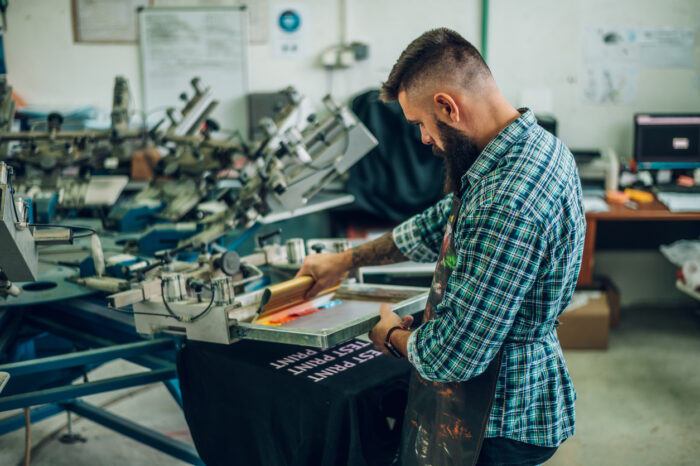
Quality t-shirt prints are more than just fashion statements. They are works of art that express individuality, promote brands, and foster a sense of community. Whether it’s a catchy slogan, a striking illustration, or a captivating logo, a well-executed t-shirt print can leave a lasting impression.
Achieving flawless t-shirt prints involves a combination of creative design, meticulous preparation, and the right techniques.
In this blog post, we will delve into the intricacies of creating exceptional t-shirt prints, from the initial design concept to selecting the perfect fabric and mastering the process.
Understanding the Basics of T-Shirt Design

Before diving into the technicalities of t-shirt printing, understanding the basics of design is crucial. A successful design should consider factors like size, placement, and alignment on the t-shirt. Keep in mind the target audience and the message you want to convey through the print.
Simple designs often work best, as they are easily recognizable and visually appealing. Consider the color as well, as it can significantly impact how the design stands out. Striking the right balance between creativity and simplicity is the key to creating eye-catching prints.
Choosing the Right Fabric
Choosing the right fabric is a pivotal decision that can make or break the quality of your t-shirt prints. Each fabric type interacts with ink differently, directly influencing its vibrancy, durability, and overall appearance.
Cotton, with its natural fibers, remains a popular choice as it allows vibrant colors to stand out and ensures a soft, comfortable feel. Blends, such as polyester cotton or rayon cotton, offer enhanced durability and wrinkle resistance, making them suitable for active wear or long-lasting designs.
Jersey knit, known for its smooth surface, is perfect for detailed patterns, while tri-blends combine the best of three fibers, providing a unique vintage texture. Whether you opt for 100% cotton or a blend, understanding the characteristics of each fabric and its compatibility with the technique ensures that they not only look great but also stand the test of time.
Preparing Artwork for Flawless Prints

Preparing artwork correctly is a critical step in ensuring flawless prints. Use vector graphics when possible, as they can be scaled without losing quality. Convert fonts to outlines to avoid any font-related issues during stamping.
Check the color mode – CMYK is suitable for stamping, while RGB is for digital displays. Define dimensions and ensure the resolution is suitable for this method. Mockups can help visualize how the design will appear on the t-shirt. Attention to detail during the preparation stage will prevent headaches during the actual process.
Exploring Different Techniques
Various techniques cater to different design needs and fabric types. Screen printing is ideal for bold, vibrant designs on cotton shirts, while Direct-to-Garment (DTG) stamping allows for intricate, detailed patterns on various fabrics.
Vinyl stamping suits single-color designs and personalization, while sublimation works best on polyester garments. Each method has its pros and cons, and understanding them helps make informed choices that align with the design vision and budget.
The Role of Color Selection in T-Shirt Prints

Color selection can make or break a t-shirt print. It affects visibility, emotional impact, and even the cost of production. Consider the psychology of colors and how they relate to the intended message.
Limited color palettes can create an elegant look, while vibrant colors may be attention-grabbing. It’s essential to test color combinations to ensure they work well on the chosen fabric. Additionally, take into account the background color, as it can influence how the design stands out.
Addressing Common Print Design Challenges
Even with careful preparation, challenges may arise during the process. Common issues include color bleeding, registration errors, and ink adhesion problems. Addressing these challenges requires troubleshooting skills and attention to detail.
Test patterns and quality checks can identify potential issues early on, allowing for adjustments before committing to a full production run. Working closely with experts can also help overcome design challenges and ensure a successful outcome.
Best Practices for Printing on Dark Fabrics
Printing on dark fabrics requires careful consideration and adherence to best practices to achieve optimal results. The key challenge lies in ensuring that the design’s colors pop vividly on the dark background without compromising on comfort and wearability.
One of the essential steps is to apply white under the base layer before stamping the colored inks. This base creates a solid foundation for the colors to appear vibrant and true to the original design.
Additionally, it’s crucial to strike the right balance between ink opacity and comfort. Excessive ink can result in a heavy and stiff pattern, making the t-shirt less enjoyable to wear. Professionals use precise measurements and ink formulations to achieve the desired level of coverage while maintaining the fabric’s softness.
Regular maintenance and calibration of equipment are also essential to ensure consistent quality. Proper training of staff and attention to detail during the process further enhance the final output. By following these best practices, they can deliver impressive and comfortable prints that captivate wearers on dark fabric t-shirts.
Sustainability in T-Shirt Printing Processes
As the fashion industry embraces sustainability, t-shirt stamping must follow suit. Choose eco-friendly inks and stamping methods that reduce environmental impact. Water-based inks, for example, are a greener alternative to traditional plastisol inks.
Additionally, prioritize stamping on organic or recycled fabrics. Educate customers about the importance of sustainable choices and their role in minimizing the industry’s ecological footprint.
Quality Control Measures

To ensure consistent, flawless t-shirt prints, implement rigorous quality control measures. Inspect each pattern for color accuracy, registration, and defects. Monitor and calibrate equipment regularly.
Properly train and educate staff to identify and address potential issues. Feedback from customers and a commitment to continuous improvement will lead to ever-improving t-shirt quality.
Crafting Exceptional T-Shirt Designs and Prints
Creating flawless t-shirt prints is an intricate process that combines artistic vision, technical expertise, and sustainable practices. Understanding the fundamentals of design, fabric selection, and techniques lays the foundation for remarkable results.
Attention to detail, color selection, and troubleshooting skills ensure challenges are overcome, while sustainability practices contribute to a responsible fashion industry.
By following best practices and implementing quality control measures, designers and printers can craft exceptional t-shirt designs that leave a lasting impact on wearers and the world.
So, next time you put on a well-designed t-shirt, remember the craftsmanship and creativity that went into creating that flawless print.








